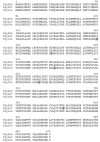Identification of invasive serotype 1 pneumococcal isolates that express nonhemolytic pneumolysin
- PMID: 16390963
- PMCID: PMC1351962
- DOI: 10.1128/JCM.44.1.151-159.2006
Identification of invasive serotype 1 pneumococcal isolates that express nonhemolytic pneumolysin
Abstract
Recently, there has been an increase in invasive pneumococcal disease (IPD) caused by serotype 1 Streptococcus pneumoniae throughout Europe. Serotype 1 IPD is associated with bacteremia and pneumonia in Europe and North America, especially in neonates, and is ranked among the top five most prevalent pneumococcal serotypes in at least 10 countries. The currently licensed pediatric pneumococcal vaccine does not afford protection to this serotype. Upon screening of 252 clinical isolates of S. pneumoniae, we discovered mutations in the pneumolysin gene of two out of the four serotype 1 strains present in the study group. Analysis of an additional 28 serotype 1 isolates from patients with IPD from various Scottish Health Boards, revealed that >50% had mutations in their pneumolysin genes. This resulted in the expression of nonhemolytic forms of pneumolysin. All of the strains producing nonhemolytic pneumolysin were sequence type 306 (ST306), whereas those producing "wild-type" pneumolysin were ST227. The mutations were in a region of pneumolysin involved in pore formation. These mutations can be made in vitro to give the nonhemolytic phenotype. Pneumolysin is generally conserved throughout all serotypes of S. pneumoniae and is essential for full invasive disease; however, it appears that serotype 1 ST306 does not require hemolytically active pneumolysin to cause IPD.
Figures



References
-
- Alexander, J. E., R. A. Lock, C. C. A. M. Peeters, J. T. Poolman, P. W. Andrew, T. J. Mitchell, D. Hansman, and J. C. Paton. 1994. Immunization of mice with pneumolysin toxoid confers a significant degree of protection against at least nine serotypes of Streptococcus pneumoniae. Infect. Immun. 62:5683-5688. - PMC - PubMed
-
- Alpern, E. R., E. A. Alessandrini, K. L. McGowan, L. M. Bell, and K. N. Shaw. 2001. Serotype prevalence of occult pneumococcal bacteremia. Pediatrics 108:E23. - PubMed
-
- Benton, K. A., J. C. Paton, and D. E. Briles. 1997. The hemolytic and complement-activating properties of pneumolysin do not contribute individually to virulence in a pneumococcal bacteremia model. Microb. Pathog. 23:201-209. - PubMed
Publication types
MeSH terms
Substances
Grants and funding
LinkOut - more resources
Full Text Sources
Other Literature Sources
Medical

